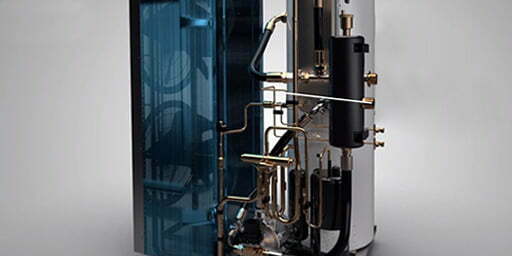Introduction to the principle of frequency conversion triple application supply of Shuntec air energy heat pump
Heating principle
The machine turns on the water pump to run, and the circulating water enters the machine. The circulating water enters the air-water separator, and the air in the water is automatically separated to ensure the safe operation of the machine. The circulating water passes through the heat exchanger, and the water circuit forms a cycle during operation. After the sensor detects the information, the compression pump starts to work. When the compression pump starts to work, high temperature and high pressure refrigerant is produced, and the refrigerant enters the heat exchanger.
After the high temperature and high pressure refrigerant transfers heat to the circulating water, it becomes a normal temperature and high pressure state. At this point, the circulating water has warmed up. The high-pressure refrigerant enters the evaporator and quickly evaporates and gasifies. With the help of the fan blades, it absorbs the heat in the air, blows out cold air, and becomes a low pressure. The low-pressure refrigerant is returned to the liquid storage tank of the compressor through the Four-way valve, and continues to work.
Refrigeration principle
The machine turns on the cooling mode and starts, and the water pump runs to circulate water into the machine. The circulating water passes through the heat exchanger to keep the normal temperature water flowing out. After the system analyzes the sensor data, the compressor starts to form a fluorine circuit. After the refrigerant is compressed by the compressor, it forms a high temperature and high pressure state, and then enters the evaporator through the four-way valve.
After the refrigerant enters the evaporator, the heat is transferred to the aluminum foil, and the fan runs to bring the heat into the air. After the high temperature refrigerant is cooled by the evaporator, it is controlled by the expansion valve to release an ice-cold gaseous state and transfer it to the heat exchanger. The icy refrigerant and circulating water fully exchange heat, and the circulating water forms cold water. After heat exchange, the refrigerant absorbs the heat of the water, returns to the compressor, and continues to work.
Hot water principle
The machine turns on the hot water mode and starts, the water pump runs, and the water in the storage tank is driven by the water pump to flow to the heat exchanger. The water system at this time: water tank – water pump – heat exchanger – water tank, forming a water circuit circulation. After the sensor detects the information, the compression pump starts to work. After the compressor pump works, a high temperature and high pressure refrigerant is produced, and then the refrigerant enters the heat exchanger.
When the high temperature and high pressure refrigerant passes through the heat exchanger, the heat is transferred to the hot water, and then the hot water returns to the water tank for continuous circulation heating. At this point, the water in the tank starts to get warmer and hotter. The high-pressure refrigerant enters the evaporator and quickly evaporates and vaporizes, absorbs the energy in the air with the help of the fan blades, blows out cold air, and becomes a low-pressure state. The low-pressure refrigerant is returned to the liquid storage tank of the compressor through the four-way valve, and continues to work.



